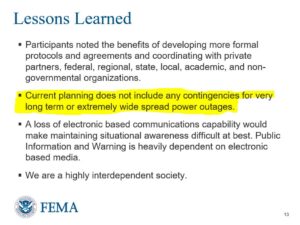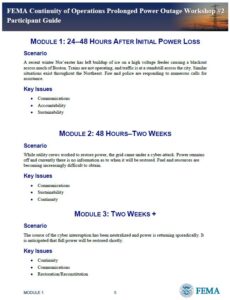Long-Term Power Outage: There Is No Plan
The federal government has no plan for a long-term power outage
 As disturbing as it might be, despite the numerous threats to the U.S. electric grid, the federal government has no plan for a long-term power outage. FEMA recently admitted this at the National Preparedness Symposium on May 24, 2018:
As disturbing as it might be, despite the numerous threats to the U.S. electric grid, the federal government has no plan for a long-term power outage. FEMA recently admitted this at the National Preparedness Symposium on May 24, 2018:
"Current planning does not include any contingencies for very long term or extremely wide spread power outages." -FEMA
We should be well on our way to having something by now. Signed into law on December 23, 2016, the National Defense Authorization Act for Fiscal Year 2017 (NDAA) added 6 U.S.C. § 321p to the United States Code, titled: “National planning and education.” This provision states:
The Secretary shall, to the extent practicable—
(1) include in national planning frameworks the threat of an EMP or GMD event; and
(2) conduct outreach to educate owners and operators of critical infrastructure, emergency planners, and emergency response providers at all levels of government regarding threats of EMP and GMD
 On March 29, 2018 I attended FEMA's Prolonged Power Outage Workshop in Boston along with several members of the Secure The Grid Coalition. While it was a well run, instructive exercise (and I offer my kudos to the FEMA staff), the three module TTX ended with this scenario in the third module (after "2+ weeks"):
On March 29, 2018 I attended FEMA's Prolonged Power Outage Workshop in Boston along with several members of the Secure The Grid Coalition. While it was a well run, instructive exercise (and I offer my kudos to the FEMA staff), the three module TTX ended with this scenario in the third module (after "2+ weeks"):
The source of the cyber interruption has been neutralized and power is returning sporadically. It is anticipated that full power will be restored shortly.
So, FEMA's idea of a "prolonged power outage" is 2+ weeks. Here are the exercise materials:
- FEMA Continuity of Operations Prolonged Power Outage Workshop #2 Participant Guide
- FEMA Continuity of Operations Prolonged Power Outage Workshop #2 AAR
This coming January, FEMA is holding a "Virtual Table Top Exercise (VTTX) - Long Term Power Outage." I plan on participating, but I see that the scenario is based on a winter storm and it appears from the "Situation Manual" that module 3 of the 3 module exercise is seven days post storm. Not exactly what I would call a "long-term power outage." I still plan on doing the VTTX and I'm sure it will be of value. (To FEMA's defense, they recently published the "Power Outage Incident Annex to the Response and Recovery Federal Interagency Operational Plans" however, this document is a high level federal government document which is of little or no help to a local community facing a power outage.)
I have previously discussed that GridEx – the industry's biennial exercise run by North American Electric Reliability Corporation (NERC) – is a paper tiger. So we have an inadequate NERC "grid down" exercise every two years and FEMA running "prolonged power outage" exercises that cover a week or two.
In terms of preparing for a long-term power outage, obviously, we're not there yet.
We need a long-term power outage exercise that covers a long-term power outage
That heading seemed pretty silly when I was typing it. But that is exactly what we need from FEMA – a long-term power outage TTX where the scenario is national in scale and months in duration – such as an EMP or GMD outage could be. No outside resources. Something like this.
Scenario: A massive solar flare (coronal mass ejection) has taken down the majority of the electric grid in the United States. Many of the extra-high-voltage (EHV) transformers have been damaged and it may be months – or longer – before power is restored. All you have is whatever resources your town or jurisdiction currently has on hand (disasters are, after all, “come as you are”). If you want to spice it up, assume this is in the worst season for your area, e.g., winter in New England or summer in Texas. Because this is a national scale disaster, you can’t count on any aid from the outside for the foreseeable future – perhaps months. The cavalry is not coming.
Exercise Objectives: (Oh, I forgot to mention, you’re going to "fail" this TTX and half the population or more of your town will die – but that’s okay. This is only a drill. The purpose of a drill is to harvest the lessons learned and make a list of what we need to do ahead of time so this loss of life never happens. The vast majority of towns, states and even the federal government have never drilled this scenario.)
The objectives are:
- Determine what resources and capabilities you have
- Determine the obvious problems your town/jurisdiction will face
- Think about things that could be done prior to an event to prepare and mitigate
The first objective is fairly simple. You probably already have a good idea of what your town’s resources are. But, your existing resources and capabilities may be less than you think. Will all your resources show up to work if their families are in jeopardy from a national catastrophe? Also, even if most of them do, remember that all you have is what you have in town now. fuel, medical supplies, number of cops and firemen. Nothing else is available.
For the second objective, I’m not even going to throw in any injects. The facts are bad enough. When the grid goes down for a long period of time, we can briefly broad-brush the challenges to a town as follows:
- Long-term interruption of power
- People will be without heat/AC.
- People will be without refrigeration.
- People will be without the ability to perform basic things like cooking or boiling water.
- People will be without basic sanitation and, hence, at risk for diseases.
- People may be without transportation immediately (EMP damage) or soon (lack of fuel).
- Most, if not all, forms of communication will be disrupted.
- Critical backup generators will soon run out of fuel.
- Long-term interruption of supply chain
- Food will stop.
- Fuel will stop.
- Medicine and medical supplies to pharmacies will stop.
- All products, parts and supplies will stop.
- Long-term interruption of essential services
- Water service will stop.
- Sewer service will stop.
- Fire, EMS, and police will be unable to respond (for lack of fuel, personnel and communications).
- Medical services will be severely disrupted or unavailable.
- Collapse of law and order (temporary or permanent)
- The police will not have the manpower, communications, or transportation to provide security for the community.
- Desperate people will resort to looting, burglary, robbery, or any means necessary to get food and water.
- It is unlikely that federal help is “on the way” anytime soon
- Many local governments will quickly become ineffective.
- Starving refugees arriving from urban areas
- Even if, miraculously, you live in a community that is prepared and has a plan to attack the above challenges, look to your nearest urban areas—refugees will soon be forced to flee the cities. Any plan for a town’s survival will have to address how to humanely handle desperate refugees while protecting the town and maintaining law and order.
- Town borders will have to be monitored and protected.
- Town assets will have to be guarded from looters/criminals.
When you really think about the implications of each of the items above – and begin to put this operating picture together, it is grim. And, local emergency management will be holding the bag. Nobody higher is coming in to become the incident commander. The National Guard can’t come to every town (and they have their own problems – guardsman are going to have a tough choice when asked to report to duty when their families are in danger.)
Let’s take one of the above problems as an example: Desperate people will resort to looting, burglary, robbery, or any means necessary to get food and water.
So, you have a grocery store and a pharmacy in town. Those are going to quickly become targets. How many meals does the average family in your town (and neighboring towns) have in the cupboard? With the supply chain gone and no food coming in, what do you think will happen one week from now when people are out of food? This means you are X number of meals away from anarchy. Can your town government and law enforcement resources handle this?
 Let’s look at another: Water service will stop.
Let’s look at another: Water service will stop.
Most people get water either from “city water” service or a well. Both require electricity. The vast majority of your town will be without their primary water supply. People are going to be at risk for waterborne diseases – if they are lucky enough to even have questionable water to drink.
As you go through and think about the implications of each of the above (and perhaps a few more that you may think of – the above list is not comprehensive) one thing becomes clear. Our emergency management system’s dependence on outside resources when the size of the disaster overwhelms the local capabilities has failed us here. We need to be able to depend on ourselves in this worst-case national catastrophe scenario.
It is also clear that for any town or jurisdiction to adequately prepare, mitigate, respond and recover from a long term electric grid outage, we need to do a lot of work beforehand. This brings us to the third objective: what could be done prior to an event to prepare and mitigate?
The answer is a lot.
The answer is not “that could never happen” (because it could) or, “if that happened, there is just no way to be prepared for it” (because that is just patently false). Several members of Congress have been concerned about this vulnerability of the electric grid for years and there are reams of Congressional testimony and federal reports that conclude that this can happen. Moreover, several members of congress advocated in 2012 that communities start a civil defense program and be prepared to fend for themselves in the absence of federal assistance for a prolonged period of time.
Every "challenge" listed above that your town faces, has a solution. But the trick is that the challenges must be addressed ahead of time. Once the lights go out, it is too late to plan. At that point, all you can do is react.
Some initial suggested steps.
- Every town and jurisdiction should do a table top exercise with a national-scale long-term power outage scenario (months).
- Nobody has a budget for this – you will need community involvement. Starting a Community Emergency Response Team (CERT) or involving your CERT Team if you have one, is a great way to start getting the community involved.
- Consider starting a non-profit civil defense organization that has this specific mission:
(a) To educate and promote individual, family, and town preparedness for disasters;
(b) To provide disaster assistance and relief to town residents in the event of a disaster; and
(c) To educate and provide planning and resource options to the town for preparation and response to a “worst-case,” long-term catastrophe affecting the town.
Some members of Congress attempted to pass a resolution advocating that communities and their citizens do this. While House Resolution 762 (112th Congress) may have died in committee along with other legislation to protect the electric grid, a good idea does not need to pass congress to be a good idea.
Are we ready for a national scale long-term power outage? Not by a long shot - and it will be too late to figure it out once the lights go off. We need to start talking about and "TTXing" this now.
